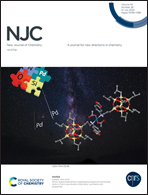Highly stable and Pb-free bismuth-based perovskites for photodetector applications
Abstract
Herein, we report the synthesis of highly stable, Pb-free bismuth iodide (BiI3 or BI), stoichiometric methylammonium bismuth iodide [(CH3NH3)3Bi2I9 or MA3Bi2I9 or s-MBI] and non-stoichiometric methylammonium bismuth iodide [(CH3NH3)2BiI5 or MA2BiI5 or Ns-MBI] perovskite thin films for photodetector applications. These films are synthesized at room temperature by a single step solution process spin coating method. The structural, optical, and morphological properties of these films were investigated using different characterization techniques such as XRD, Raman spectroscopy, FE-SEM, UV-Visible spectroscopy, etc. Formation of BI, s-MBI and Ns-MBI thin films is confirmed by XRD and Raman spectroscopy measurements. XRD analysis reveals that BI has a hexagonal crystal structure and a P63/mmc hexagonal space group for s-MBI and Ns-MBI. The optical properties of BI thin films show a high absorption coefficient (∼104 cm−1) and a band gap of ∼1.74 eV. Similarly, s-MBI films have a high absorption coefficient (∼103 cm−1) and an indirect band gap of ∼1.8 eV. Moving from s-MBI to Ns-MBI, the value of absorption coefficient is ∼103 cm−1 and the band gap corresponds to ∼2 eV. Finally, photodetectors based on the synthesized BI, s-MBI and Ns-MBI perovskites have been directly fabricated on FTO substrates. All photodetectors exhibited highly stable photo-switching behaviour along with excellent photoresponsivity and detectivity, with a fast response and recovery time. Our work demonstrates that Pb-free BI, s-MBI and Ns-MBI perovskites have great potential in the future for realizing stable photodetectors.



 Please wait while we load your content...
Please wait while we load your content...